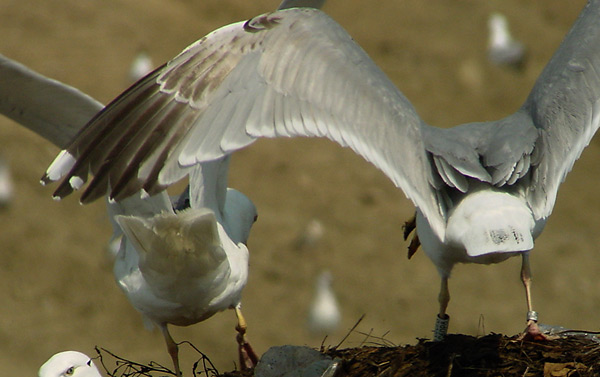 Herring
Gull - Zilvermeeuw (argentatus & argenteus): sub-adult July
Herring
Gull - Zilvermeeuw (argentatus & argenteus): sub-adult July
(last update: 23 maart 2004)
Home
Links
to Gull Sites
Gull Taxa
Gull Topography
Grey & Colour Charts
Locations in NW Europe
Summaries of Articles
About ORG
@
Herring Gull C60P8 5cy (argentatus), July 15 2003, Tampere, Finland (61.31N, 23.43E).

5cy argentatus, ringed white C60P8
as pullus
on June 15 1999 in Pälkän, Finland (61.30N 24.13E). There are a few
dozens of observations from Tampere
dump from mid-summer to November.
The complete moult has started with the median wing-coverts missing and the inner primaries recently moulted.
Primary P5 has been dropped and P6-P10 are still fourth generation. There
is a large mirror P10 and a small mirror on the old P9. P1-P4 are fully
grown fifth generation fight-feathers and much adult-like. The fourth
generation secondaries and tail-feathers are still all present; the
secondaries show a pale brown wash and the central tail-feathers show
obvious black markings. Note the dark outer greater primary coverts.
From June to December, sub-adult argentatus undergo a complete moult resulting in so-called "winter plumage". From June onwards, the new plain grey wing-coverts are moulted in, starting with the outermost median coverts and followed by the inner medians, the inner greaters, and the rest of median and lower lesser coverts. By August, the first neat streaks can be found on the crown and hind-neck. After the complete moult is finished by late autumn, the head will show extensive 'winter streaking' in argenteus, often neat fine streaking in sub-adult argentatus. Also, by the end of the complete moult, the scapulars, mantle and all the wing-coverts will be replaced and near-adult argentatus can hardly be distinguished from full adult plumage (except more black on the bill and often the dark centres in the outer greater primary coverts).
During the summer, the primaries are replaced. In argentatus, the last outer primary P10 will be fully grown by early December, slightly later than in West-European argenteus. However, first data from Tampere, Finland indicate that 3cy argentatus from this region are not delayed in primary moult compared to argenteus.
Adult northern argentatus show a
different pattern in the outer primaries, compared to argenteus. In
argentatus, especially from northern Scandinavia, the black markings
on P5 are very limited and, if black on P5 is present, this black often
has diffuse edges. More often, these black sub-terminal markings are
completely lacking on P5. In Baltic argentatus populations,
normally black on P5 is confined to the outer-web, with sharply defined
edges.
Argenteus normally has a black sub-terminal band on the top of P10,
dividing the tip from the mirror. If the black sub-terminal band on P10 is
broken, the outer-web of P10 still shows black marking. Argentatus
normally completely lacks sub-terminal markings, also on the outer-web of
P10. Some argentatus completely lack black on the edge of the
inner-web, creating a so-called "thayeri pattern".